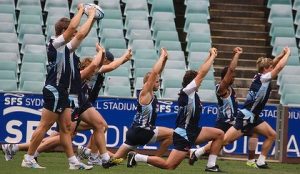Article by Leighton Bradgate.
Flexibility is defined as the range of movement (ROM) at a given joint, which can be both active (under muscular control) and passive (under control of external forces).
Research into the use of stretching and warm-ups for athletic performance is known to have begun in the 1930’s and to date it has been suggested that the main immediate benefits are to increase performance and reduce risk of injury. These benefits to performance are believed to occur due to a number of factors, such as an increase in ROM at joints, enhanced muscular coordination and a reduction in muscular resistance to movement. However, there is a lack of clarity in the stretching literature that coaches and athletes often base their decisions on personal experience.
to have begun in the 1930’s and to date it has been suggested that the main immediate benefits are to increase performance and reduce risk of injury. These benefits to performance are believed to occur due to a number of factors, such as an increase in ROM at joints, enhanced muscular coordination and a reduction in muscular resistance to movement. However, there is a lack of clarity in the stretching literature that coaches and athletes often base their decisions on personal experience.
There has been a trend towards avoiding the use of static stretching protocols immediately prior to performance and a focus on dynamic stretching due to the much publicised view that static stretching immediately before athletic performance reduces levels in strength and power tasks and only has minimal benefits if any, on reducing injury risk. Dynamic stretching has the ability to enhance strength and power performance by improved muscular activation.
It is common now to observe athletes, prior to performance, completing an aerobic warm-up, followed by dynamic stretching, and finally by a sport-specific warm-up element. However, it should not be overlooked that in sports where an extreme ROM is required, static stretching protocols may still benefit performance by increasing ROM available at joints.
There is also conflicting research in response to static stretching protocols. It is believed that this is probably due to differences in the volume and intensity of static stretching performed in the studies and also the use of additional pre performance warm-up strategies.
With regards to volume of stretching, the studies finding no negative effects of static stretching have often used a lower volume of stretching compared to those finding a negative effect. Studies observing reduced strength and power performance have often used static stretching intensities to a point of pain.
Recent studies have negated any potential negative effects of a  pre performance combination of an active warm-up or dynamic stretching with a lower volume and intensity of static stretching. It was observed that static stretching using low intensity and volume static stretching 1-15 mins prior to performance had no negative effects in vertical jumps heights, throwing speeds or 100metre sprinting when combined with dynamic stretching and or an aerobic warm-up element.
pre performance combination of an active warm-up or dynamic stretching with a lower volume and intensity of static stretching. It was observed that static stretching using low intensity and volume static stretching 1-15 mins prior to performance had no negative effects in vertical jumps heights, throwing speeds or 100metre sprinting when combined with dynamic stretching and or an aerobic warm-up element.
Thus it would seem that low volume and moderate intensity stretching methods conducted prior to subsequent an active warm up element may not be detrimental to performance particularly if the subsequent performance is at least 10-15 minutes after the stretching protocol and may actually be beneficial when extreme ROM’s are required.
Static stretching pre performance guidelines:
• Low Volume: 1-2 sets
• Short Duration: 10-25 seconds
• Moderate intensity: gentle pull, short of pain
• Performed at least 10-15 minutes prior to performance
